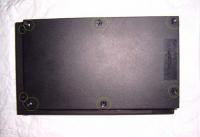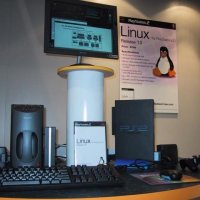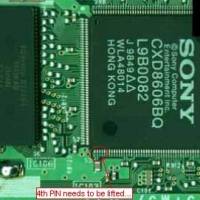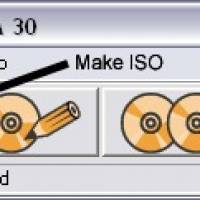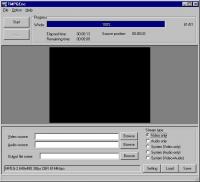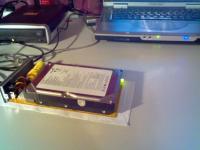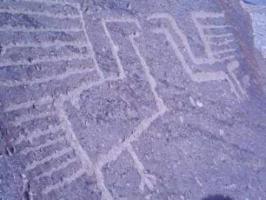The Playstation 2 hardware guide
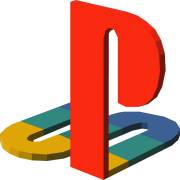
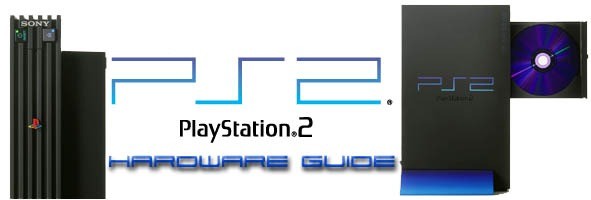
Well, you are one of the lucky people to have bought an imported PlayStation 2 console (probably by spending your entire college fund). After tossing all your old, out-dated, consoles to the floor and placing your new bundle of joy in their place, you’re ready for action. Or are you?
After booting up the system you find that the menus are all in Japanese. How do you boot a DVD movie? What about running an old PlayStation game with smoother textures and slightly faster load times? How would you like to make those menus (NOT the games) English?
This guide currently covers:
- Setup & Display
- The different ways to set up, connect and display the PS2.
- Operation
- How to safely turn on, reset, and power down the system.
- Menu Screens
- Turn the system menu screens into English. Explanation of each menu option.
- Playing PlayStation (PSX) Games on PS2
- Run your old PlayStation games with smoother textures and slightly quicker load times.
- DVD Playback
- Watching a DVD movie on the PS2.
- The Browser
- Find out how to manage your memory cards and listen to audio CDs.
- The Utility Disk
- Find out what the the Utility Disk is all about.
Note: This guide is written for the Japanese PlayStation 2 console, which was released on March 4th, 2000 IN JAPAN. The American and European PlayStation 2 consoles are due to be released in their respective countries sometime in fall 2000. For the latest updates on the PS2’s release outside of Japan, keep an eye on IGNPS2.
We will be updating this Hardware Guide as time goes on with new images and more information.
Setup & Display
The PlayStation 2 can displayed either vertically or horizontally. Right out of the box, you can display it either way, but Sony does offer optional stands for each position. The horizontal stand is pretty pointless, but the vertical one is pretty necessary to maintain the systems balance. As I said, you can display it vertically right out of the box, but you may want to get a stand just to make sure it won’t tumble over.
As with the original PlayStation (and most consoles in general), there are a couple things you want to keep in mind:
- Do not set the console on thick carpet. This can amplify the heat already generated by the system, which can cause it to overheat.
- Do not keep the system in a small alcove of an entertainment center where it won’t get enough ventilation.
- Do not play for extended period of time. Try to take a hour break every few hours to allow the system to cool down.
There have already been reports of PS2’s having similar heat problems as the original PlayStation, but if you follow those three simple rules you should be fine.
As with almost any new video game system, there is a new piece of hardware to learn. Use these next two images to familiarize yourself with the new powerhouse:

- Memory Card and Controller Ports: These work exactly as they did on old PlayStation. Just put your memory card into the top slot, and your controller into the bottom.
- CD/DVD Drive: By pressing the "Eject" button (#4) this tray will gently slide out allowing your to insert or remove your favorite game, movie or CD.
- Reset Button: This is the magic button that controls your power of the PS2. One press will reset the system to the main menu, by holding it down you can put the system into "Sleep Mode". We will cover this more later in the guide.
- Eject Button: By pressing this, you can open the CD/DVD drive tray to insert or take out a disc.
- Two USB Ports: A very large majority of PC/Mac peripherals use USB now. These two ports open up the PS2 to all sorts of new options such as keyboards, mice, and additional controllers.
- i-Link Port: Many digital cameras and camcorders these days come equipped with i-Link compatibility. This little plug in will allow future compatibility with items such as those. Imaging putting yourself into the game using a image of your own face taken from a digital camera. That can be possible very soon using this port.
- Main Power Button: This switch basically turns on and off the PS2. We will cover this more in depth later in the guide.
- AC In: This is where you plug in the power cord.
- AV Multi-Out: You connect all video cables (RFU, RCA, S-Video, Component) here.
- Digital Out: You use this to connect your PS2 to a Dolby Digital/DTS receiver or other Digital-ready equipment.
- Type III PCMCIA: If you use a laptop PC, there is a good chance it uses some form of PCMCIA hardware (a modem is very common). This is where more future upgrades (such as a high-speed modem, or hard drive) will attach to the PS2.
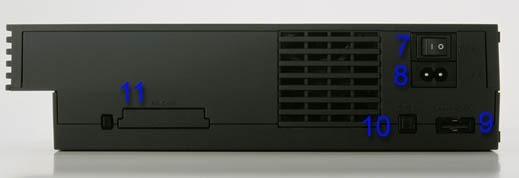
Operation
Putting the PS2 to sleep.
No, I’m not talking about killing the system in a humane way, but rather powering the thing up, and safely shutting it down. This system is not like any other on the market when it comes to this aspect of the design. In this matter is more closely resembles a PC than a console.
There is a master power switch on the rear of the system, right above the power and video plugs.
This basically turns on and off the system, but there is more to it than that.
Once the switch is turned on, the light near the "Reset" button will turn red. The system is at that time in sleep mode (it’s basically "off" right now, but power is still going into the system). To turn it on, press the "Reset" button to change the light to green and start the system boot up sequence.
Pressing the "Reset" button once will reset the system back to the boot menu, while holding it down will put the system into sleep mode.
It is a good idea to keep the system in sleep mode while not in use (current DVD players are like this when you turn them off). It’s best to only hit the master power switch at the end of the night or when you will be away for a while (like at work).
Menu Screens
How to turn the system menu screens into English.
When you first access the system menu (by booting the system without a disc in it), you will be presented with Japanese menus. Well there is an easy way to fix this, if you just follow these simple instructions:
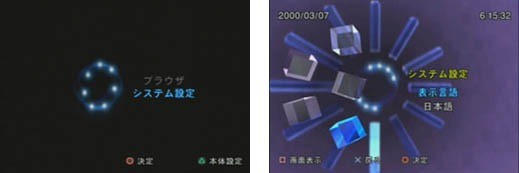
The first image shows you the main menu. Select the bottom option (which is System Configuration) to shift into the next series of menus. There are five cubes here, each one leading to another option. As shown in the second image, select the bottom cube (the blue color is showing that it is selected). This is the language option, which takes us to the next step…
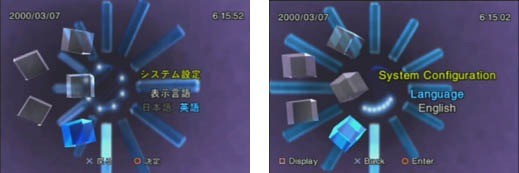
After selecting that option, you will be presented with two choices (the first image). Select the second one to change the menu screens into English. Unfortunately the memory card, CD audio, and DVD video options will still be in Japanese.
PLEASE NOTE: This only changes the system menus to English, NOT the games.
The menu options
The language menu is just one of the many features in the PS2’s System Configuration menu. The following images will detail the rest of those features:
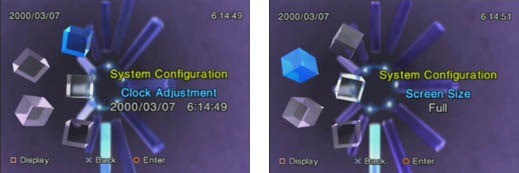
The first image shows the Clock Adjustment option. This is usually already set when you get your PS2 (a nice feature), but it is here where you can reset it if you ever need to. The second option sets the default size of the menus for your TV. You get two options, 4:3 (normal TV’s) or 16:9 (widescreen TV’s). Again, this only affects the menu screen size, but some games will make use of the extra screen space that a Widescreen TV provides.
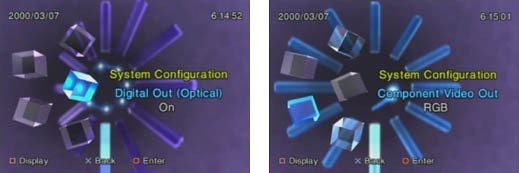
These next two menus are the activation for the Digital Out and Component Video Out ports on the PS2. Both of these are for those of you who have high-end home theater systems.
Playing PlayStation (PSX) Games
How to play a standard PlayStation CD game on the PlayStation 2
One of the coolest features of the PlayStation 2 is the ability to play all of your old PlayStation games on it. What isn’t widely known (at least not until the PlayStation Festival in Japan) is that the PS2 can actually slightly improve the textures and load times of some PlayStation games.
Now, it should be noted that not all PSX games are able to run with these enhancements. If you do encounter a problem with a PSX game while running one or both of the enhancements, simply turn it off from the menu as shown in the following screens:
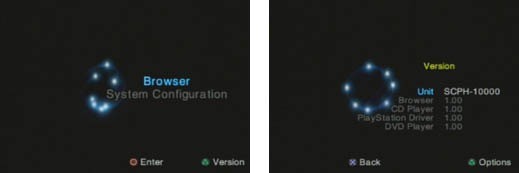
The first screen shows the main menu. While there, press Triangle to bring up the Version info screen. This screen shows the version numbers for the various functions within the system. Select "PlayStation Driver" and press the Triangle to bring up the following options:
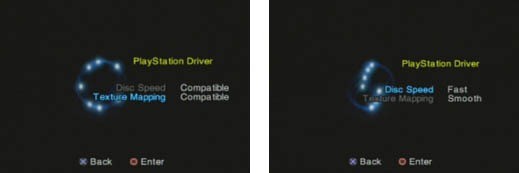
These last two screens show the two options you can set for PlayStation games:
Drive Speed sets how fast the drive reads the CDROM. Fast is the upgrade, while Compatible is normal speed. Some games (such as Final Fantasy VII and VIII) experience glitches when running under the Fast option as they were programmed with carefully calculated disc access.
While it doesn’t make a massive difference (the load times on games that work with this are only decreased by about two or three seconds), it is a very nice option.
Texture Mapping smoothes out textures in the games that it is used on. Again, not all games will work with this since some used software tricks to enhance the textures in the game when running on the existing PlayStation.
Once you have your options set, the system will start up the game as normal. The system will save the driver settings, so when you start up the machine with a PSX game in the drive, you won't have to go to these menus to start it.
DVD Playback
How to run a DVD Movie (Region 2 ONLY) on your PS2
Since the PlayStation 2 is also a DVD Movie player, it can play DVDs from the country in which it falls within the "Territory Region Coding". For those of you who are new to DVD, here is a quick explanation of what this means.
When the DVD movie format was created, the big movie studios began to worry about releasing a movie in one country on DVD when it is just opening on screens in another. Also, the studio that distributes a movie can differ from country to country. So, the Region Coding was created.
There are currently eight codes, which are:
- North America (US, Canada, and the respective territories).
- Japan, Europe, Egypt, South Africa, and the Middle East
- Hong Kong, Southeast and East Asia
- Australia, New Zealand, Mexico, South and Central America, the Carribean, and the Islands in the Pacific.
- Indian Subcontinent, Mongolia, the Former Soviet Union (Russia), North Korea, and Africa.
- China
- No countries yet
- Special. This means that 8 is not set to any specific country, but is still a region code. Discs classified region 8 are most commonly seen on airlines and other travel vehicles.
The way the PS2 works this out is by storing the DVD driver for the system on the 8MB Memory Card in a file that cannot be copied, deleted, or otherwise tampered with. Since the imported PS2 is from Japan, it can only play DVDs coded for Region 2.
Code to get past the Region lock-out!
There is a code out there that will allow you to run NTSC DVD's from nearly every region on your PS2. There are some limitations though. First, it will only work with Version 1.0 of the DVD Driver (you can see that in the Version menu of the system). Also, not all DVD's will run with this code, while others will run with limited features (some menus may not load correctly is one example).
The code is:
- Get a regular old, NON-ANALOG PlayStation controller (the Sony one).
- Put it into Controller port 1.
- Load a DVD while holding "Up" on the controller until you see the DVD menu appear.
- Then, hit play.
We have tested this code and found that it works a good percentage of the time. Again, this will not work with any version of the DVD driver newer than 1.0, and it will not play every DVD.
If you happen to import a DVD from Japan, or have a DVD that can be played in multiple regions, simply plug in your 8MB Memory Card that has the DVD driver file, and then insert your DVD movie. The system will boot it just like a game or music CD.
Since there is not yet a remote control out of the system, you can use your controller to navigate the DVD menus and control the movie just as if you had a remote.
The controls are:
- D-Pad: Moves the cursor to navigate menus.
- Select: Brings up the on-screen commands. This is basically like having a remote control on your TV screen. You can either use that or just use your normal controller.
- Start: Plays or pauses the video.
- L1: Go back a chapter.
- L2: Rewind
- L3 (press left analog stick): Change the subtitles
- R1: Go forward one chapter.
- R2: Fast forward.
- R3 (press right analog stick): Change the audio/language option.
- Square: Go to DVD Title menu.
- X: Cancel button.
- O: Accept button.
- Triangle: Go to the DVD Main menu.
The Browser
As with the PSX before it, the PS2 has the ability to play Audio CDs and manage your memory card files via on on-screen menu. In the case of the PS2, this menu is called the "Browser". From here you can copy or delete memory card files and listen to an audio CD. When you access this menu you will see exactly what media is currently in the system.
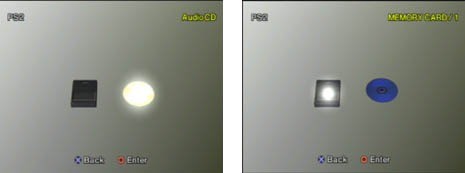
The Browser menu will show you exactly what you have in the system. PS2 Memory cards are black, while PSX cards are gray. There is even an icon for the Pocketstation!
On the disc side Blue is a PS2 CD, Black is a PSX CD, while Audio CD’s and DVD’s are silver or gold.
Selecting an audio CD, will bring you to the playback menu:
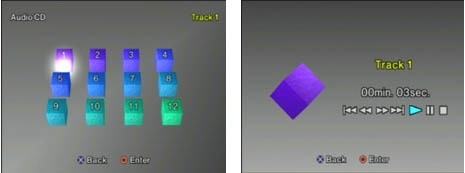
The fist image shows you where you can select your tracks. The next one shows you the Audio CD controls. It is laid out just like any other music player, and that is pretty much all there is to it.
Moving on to the Memory card screen (simply select the memory card from the menu), you find one of the cooler new features of the PS2. Instead of just having a flat image to display a saved game or file, the PS2 displays them via a fully 3D (and sometimes animated) icon. These icons can also change depending on what you do in the game. For example, when you complete Ridge Racer V, its saved game icon turns from a little car to a 3D icon of Ai (the newest Ridge Racer babe).
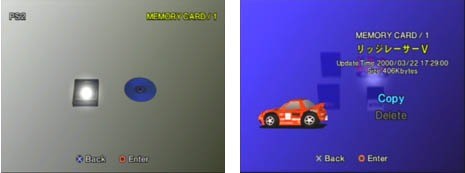
As you can see in the image, once you have a file selected you can easily copy it to another card or delete it.
The Utility Disk
Inside the PS2 box is a small blue CD sleeve containing the Utility Disc. On this CD is a PS2 walkthrough (in Japanese) that is similar to this guide.
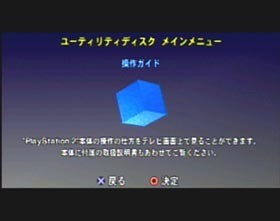
When you start up the system with the disc in the drive, you will be presented with this screen. Hit "X" to exit out, or "O" to continue to the next screens.
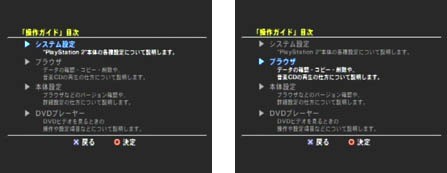
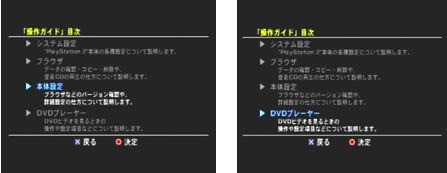
The top four screens show the main menu of the Utility disc. We went through all these menus for you, and their descriptions are below:
- This is a walkthrough of the system menus (just like the one you are reading).
- The second option is a description of the Browser menu, which we also cover in this guide.
- Number three is an explanation of the Version screens that are accessed from the system’s boot up menu.
- The fourth option is probably the most important option on this disc menu. It is here that the back up DVD Driver is hidden. This driver is needed on your memory card in order to run a Region 2 DVD movie. It should be noted that this driver is already on the memory card that comes with the system. You only need to download the driver if your existing one becomes corrupted.
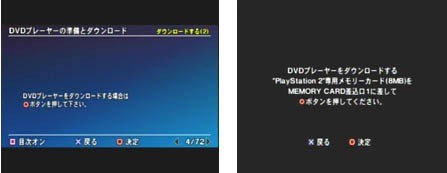
To access the driver, go into the menu, and then go forward to entry #4. Hit "O" to select it and then "O" again to begin the download. You will be prompted to select "yes" or "no" if you really want to download the Driver.
Another very cool extra on the Utility disc is a MPEG2 demo video hidden at the very end of the DVD section. To view it, go forward to entry #72 and press "O". We snapped some images of this crystal clear underwater scene for you:











